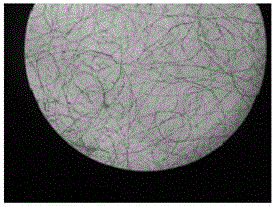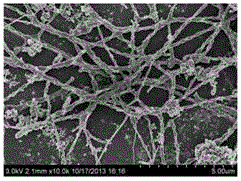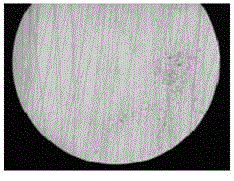An ethanol sensor based on a zinc oxide nanometer structure and a preparing method thereof
A zinc oxide nano and zinc oxide nanowire technology, applied in the field of sensors, can solve the problems of complex preparation process, low sensitivity, and long response time, and achieve the effect of simple preparation process, high sensitivity, and fast response time
- Summary
- Abstract
- Description
- Claims
- Application Information
AI Technical Summary
Problems solved by technology
Method used
Image
Examples
no. 1 Embodiment approach
[0069] An ethanol sensor based on a zinc oxide nanostructure, comprising two sets of electrodes forming interdigital electrodes, and a zinc oxide nanofilm arranged on at least one surface of the interdigital electrodes; the zinc oxide nanofilm is composed of a hexagonal wurtzite crystal phase Zinc oxide nanowires.
[0070] figure 1 Shown is a schematic diagram of the structure of the interdigitated electrode. The two groups of electrodes form an interdigitated shape, and the two groups of electrodes are not connected, forming the signal output end of the ethanol sensor. The interdigitated electrodes of the present invention are made by conventional methods. Specifically, electrode materials are deposited or coated on the substrate to form two groups of electrodes in the shape of interdigitated electrodes. The thickness of the interdigitated electrode of the present invention is about 50nm-100nm.
[0071] The present invention has no special regulations on the substrate use...
Embodiment 1
[0101] The size of the ethanol sensor obtained in this example is 2 cm×2 cm, the thickness of the zinc oxide nano film is 500 nm, and the diameter of the zinc oxide nanowires constituting the zinc oxide nano film is 300 nm. The preparation method of this ethanol sensor will be described below.
[0102] (1) Preparation of interdigitated electrodes
[0103] Using gold foil as a target, magnetron sputtering is used to deposit interdigitated electrodes on a silicon chip with a thickness of about 70 nanometers.
[0104] (2) Preparation of electrospinning solution for zinc oxide nano-membrane
[0105] Slowly add 22.7g of polyvinylpyrrolidone (PVP, molecular weight 1.3M) into 10ml of methylformamide (DMF), after the polyvinylpyrrolidone is dissolved, slowly add 0.9g of zinc acetate and 0.33g of SnCl 2 2H 2 O, and then mixed uniformly to obtain an electrospinning solution.
[0106] (3) Electrospinning
[0107] Add the electrospinning solution obtained in step (2) into the injecti...
Embodiment 2
[0113] The size of the ethanol sensor obtained in this example is 2 cm×2 cm, the thickness of the zinc oxide nano film is 600 nm, and the zinc oxide nano film is composed of parallel zinc oxide nanowires with a diameter of 300 nm. The preparation method of the ethanol sensor will be described below.
[0114] (1) Preparation of interdigitated electrodes
[0115] Using gold foil as a target, magnetron sputtering is used to deposit interdigitated electrodes on a silicon chip with a thickness of about 70 nanometers.
[0116] (2) Preparation of electrospinning solution for zinc oxide nano-membrane
[0117] Slowly add 22.7g of polyvinylpyrrolidone (PVP, molecular weight 1.3M) into 10ml of methylformamide (DMF), after the polyvinylpyrrolidone is dissolved, slowly add 0.9g of zinc acetate and 0.33g of SnCl 2 2H 2 O, and then mixed uniformly to obtain an electrospinning solution.
[0118] (3) Electrospinning
[0119] Add the electrospinning solution obtained in step (2) into the i...
PUM
| Property | Measurement | Unit |
|---|---|---|
| diameter | aaaaa | aaaaa |
| thickness | aaaaa | aaaaa |
| thickness | aaaaa | aaaaa |
Abstract
Description
Claims
Application Information
 Login to View More
Login to View More - R&D
- Intellectual Property
- Life Sciences
- Materials
- Tech Scout
- Unparalleled Data Quality
- Higher Quality Content
- 60% Fewer Hallucinations
Browse by: Latest US Patents, China's latest patents, Technical Efficacy Thesaurus, Application Domain, Technology Topic, Popular Technical Reports.
© 2025 PatSnap. All rights reserved.Legal|Privacy policy|Modern Slavery Act Transparency Statement|Sitemap|About US| Contact US: help@patsnap.com



